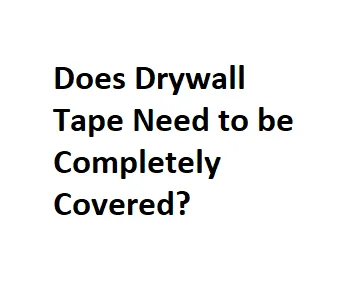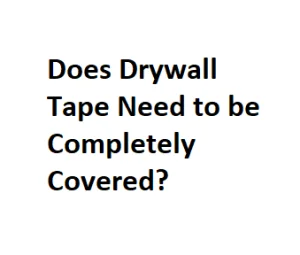When it comes to the world of drywall, one of the common questions that DIY enthusiasts and even professionals often grapple with is whether drywall tape needs to be completely covered. It might seem like a straightforward query, but the answer involves a delicate dance between aesthetics, functionality, and the overall longevity of your drywall installation.
Understanding Drywall Tape:
Drywall tape plays a crucial role in the process of creating seamless and smooth walls. It is used to bridge the gaps between drywall panels, providing reinforcement and preventing cracks from forming over time. There are two main types of drywall tape: paper tape and mesh tape. While the application process may differ slightly between the two, the question of whether they need to be completely covered remains a central consideration.
The Case for Complete Coverage:
One school of thought argues that drywall tape should be completely covered for a polished and professional finish. Proponents of this approach emphasize that a fully covered tape helps create a smooth surface, minimizing the risk of visible seams and imperfections. This method is often recommended for those who prioritize a flawless appearance in their finished drywall.
Additionally, covering the tape entirely ensures that it is adequately protected from moisture, reducing the chances of deterioration over time. Moisture infiltration can compromise the structural integrity of the tape, leading to issues like peeling or cracking in the long run.
The Art of Feathering:
On the flip side, there’s another perspective that suggests a technique known as feathering. Feathering involves applying joint compound in a way that thins out towards the edges, creating a gradual transition between the tape and the surrounding drywall. This method aims to blend the tape seamlessly into the wall, minimizing the prominence of the joint.
Proponents of feathering argue that it not only provides a visually appealing result but also reduces the amount of sanding required in the finishing stages. Less sanding means less dust and a quicker overall project completion.
Finding the Balance:
In the end, the decision of whether to completely cover drywall tape depends on various factors, including personal preferences, project goals, and the specific characteristics of the drywall tape being used. Striking a balance between coverage and feathering is often the key to achieving both a durable and aesthetically pleasing finish.
Tips for Applying Drywall Tape:
- Choose the Right Tape: Selecting the appropriate type of drywall tape is crucial. Mesh tape is often preferred for its flexibility, while paper tape is known for its strength. Consider the specific needs of your project when making this choice.
- Preparation is Key: Ensure that the surface is clean, dry, and free of any debris before applying the tape. Properly prepare the joint by embedding the tape into a layer of joint compound.
- Complete Coverage for Critical Joints: In areas that are more prone to stress, such as corners, it’s generally advisable to fully cover the tape. This added layer of joint compound provides extra reinforcement, reducing the likelihood of cracks forming in these vulnerable spots.
- Feathering for Seamless Transitions: Use the feathering technique in less critical areas where stress is minimal. This method creates smooth transitions and minimizes the appearance of seams, especially in areas with ample natural light.
- Layering for Durability: Applying multiple layers of joint compound, with each layer extending slightly beyond the previous one, contributes to the overall strength and durability of the joint. This technique helps ensure that the tape is well-embedded and protected.
- Sanding with Precision: Regardless of the chosen approach, proper sanding is essential for achieving a flawless finish. Take your time to sand the joints carefully, smoothing out any imperfections and achieving the desired texture.
- Prime and Paint: Once the joint compound is dry and sanded, it’s crucial to prime the surface before applying paint. This not only enhances the adhesion of the paint but also provides an even finish.
Advanced Techniques for Drywall Tape Application:
- Consider Taping Techniques: Experiment with different taping techniques based on the specific needs of your project. For instance, the “California” or “topping” technique involves applying a thin layer of joint compound over the tape, reducing the risk of visible joints while maintaining strength.
- Mesh Tape for Stress Points: In high-stress areas where movement is common, mesh tape is often preferred. Its flexibility allows it to better handle the expansion and contraction of the walls, reducing the likelihood of cracks appearing over time.
- Use Setting-Type Joint Compound: For added durability, especially in areas prone to moisture, consider using setting-type joint compound. This compound hardens through a chemical reaction, providing a more robust and resilient finish compared to standard joint compounds.
- Apply Thin Coats: Instead of applying a thick layer of joint compound in one go, consider using thin coats. This not only speeds up the drying process but also makes it easier to achieve a smooth and even finish.
- Blend with Existing Walls: When repairing or patching existing drywall, pay special attention to blending the new tape with the surrounding wall. Feather the edges carefully to create a seamless transition between old and new surfaces.
- Use Backer Boards for Butt Joints: Butt joints, where the ends of two drywall sheets meet, can be challenging. Strengthen these joints by using backer boards. Apply joint compound over the backer board, tapering the edges to create a smooth surface.
Troubleshooting Common Issues:
- Crack Prevention: To minimize the risk of cracks, ensure that the joint compound is applied evenly and extends beyond the edges of the tape. Additionally, consider adding fiberglass mesh tape for added strength in areas prone to movement.
- Address Bubbles and Blisters: Bubbles or blisters can occur if there’s air trapped beneath the tape. To prevent this, press the tape firmly into the joint compound, eliminating any air pockets. If bubbles do appear, carefully cut out the affected section, reapply joint compound, and re-tape.
- Minimize Shrinkage: Joint compound can shrink as it dries, potentially leaving a depression around the tape. Use joint compounds with minimal shrinkage properties or apply multiple thin coats to reduce this effect.

